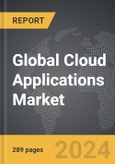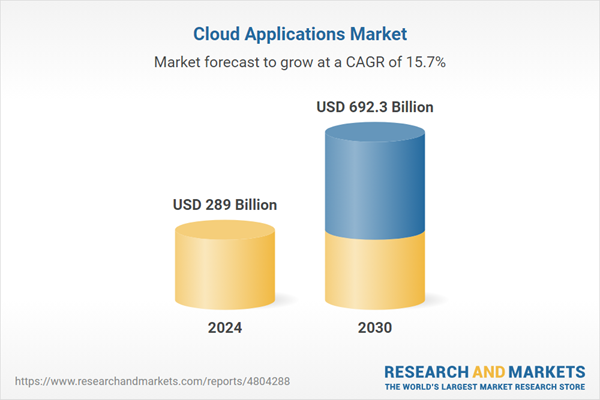Global Cloud Applications Market - Key Trends and Drivers Summarized
Why Are Cloud Applications Becoming the Backbone of Modern Business Operations?
Cloud applications have rapidly emerged as the backbone of modern business operations, offering unmatched flexibility, scalability, and efficiency. Unlike traditional software that requires installation on individual devices or servers, cloud applications run on remote servers hosted on the internet, enabling users to access them from anywhere with an internet connection. This shift has revolutionized how businesses operate, allowing for more agile workflows, real-time collaboration, and cost-effective IT management. The cloud-based model removes the need for substantial upfront hardware investments and ongoing maintenance costs, which is especially valuable for organizations seeking to streamline operations and adapt quickly to changing market conditions. In industries ranging from retail and manufacturing to healthcare and finance, cloud applications are being used to manage everything from customer relationship management (CRM) and enterprise resource planning (ERP) to supply chain logistics and data analytics. As companies continue to move their critical functions to the cloud, they are gaining the ability to scale operations on demand, improve productivity, and make more data-driven decisions, positioning cloud applications as an essential tool for success in today's digital economy.How Are Technological Innovations Enhancing the Capabilities of Cloud Applications?
The capabilities of cloud applications have been greatly enhanced by several key technological innovations, transforming how businesses interact with and leverage these platforms. One of the most significant advancements is the integration of artificial intelligence (AI) and machine learning (ML) into cloud applications, enabling more intelligent and automated processes. AI-powered cloud applications can analyze large datasets in real time, providing businesses with actionable insights, automating routine tasks, and predicting future trends. For instance, in customer service, cloud-based AI chatbots are now able to handle basic queries, freeing up human agents to focus on more complex issues. Another critical innovation is the rise of serverless computing, which allows developers to build and run applications without worrying about the underlying infrastructure. Serverless models dynamically allocate resources as needed, optimizing costs and improving application performance. Additionally, the growth of containerization technology, which packages applications and their dependencies into isolated containers, is making it easier to deploy, scale, and manage cloud applications across different environments. This is particularly valuable in hybrid cloud and multi-cloud architectures, where organizations need to manage applications that run on a mix of public, private, and on-premises infrastructure. These innovations are continuously expanding the possibilities of cloud applications, allowing businesses to increase agility, reduce operational complexity, and maximize the value of their data.Where Are Cloud Applications Having the Biggest Impact?
Cloud applications are having a profound impact across numerous sectors, transforming how industries operate and deliver value. In the financial services industry, cloud applications are being used to streamline operations, enhance customer experience, and ensure compliance with regulatory requirements. Banks and financial institutions rely on cloud-based platforms for everything from fraud detection and risk management to personalized customer service and mobile banking. In healthcare, cloud applications are transforming patient care by enabling the secure sharing of electronic health records (EHRs) between providers, facilitating telemedicine, and supporting advanced medical research through big data analytics. The ability to access patient data in real time, from any location, is improving diagnosis and treatment outcomes while ensuring compliance with stringent data privacy regulations like HIPAA. In the retail and e-commerce sectors, cloud applications are central to inventory management, customer relationship management, and personalized marketing. Retailers use cloud platforms to analyze customer behavior, optimize supply chains, and improve the overall shopping experience. Moreover, in industries like manufacturing and logistics, cloud applications are being used to enhance operational efficiency through real-time tracking, predictive maintenance, and IoT integration. Across these diverse industries, cloud applications are revolutionizing business models, improving scalability, and driving innovation by enabling organizations to operate more efficiently and with greater flexibility.What Is Driving the Growth of the Cloud Applications Market?
The growth in the cloud applications market is being driven by several critical factors, chief among them being the increasing digital transformation efforts across industries. As businesses continue to modernize their operations, they are embracing cloud applications as a way to enhance efficiency, reduce costs, and gain a competitive edge. One of the key drivers of this growth is the scalability and flexibility that cloud applications offer. Unlike traditional software, cloud applications allow businesses to easily scale their operations up or down based on demand without significant investments in hardware or IT infrastructure. This is especially important in today's rapidly changing business environment, where agility and the ability to respond quickly to market shifts are crucial for success. Another important driver is the growing prevalence of remote work and distributed teams. Cloud applications enable employees to collaborate and access critical business tools from any location, making them essential in a world where hybrid and remote work models have become the norm. Additionally, the rise of data-driven decision-making is fueling demand for cloud applications, as businesses look to leverage real-time analytics and AI to make more informed and strategic decisions. Compliance with increasing regulatory requirements, particularly around data privacy and security, is also encouraging businesses to adopt cloud applications with built-in compliance and security features. Lastly, the expansion of 5G networks and edge computing is further driving the adoption of cloud applications, as these technologies enhance the speed, connectivity, and processing power needed to support more sophisticated and real-time cloud-based operations. Together, these factors are creating a strong foundation for continued growth in the cloud applications market, as more businesses recognize the strategic benefits of moving to the cloud.Report Scope
The report analyzes the Cloud Applications market, presented in terms of market value (USD). The analysis covers the key segments and geographic regions outlined below.- Segments: Segment (CRM, HCM, ERP, Content Management & Collaboration, SCM, BI, eCommerce, Other Segments); End-Use (BFSI, IT & Telecom, Retail & Consumer Goods, Manufacturing, Energy & Utilities, Media & Entertainment, Other End-Uses).
- Geographic Regions/Countries: World; United States; Canada; Japan; China; Europe (France; Germany; Italy; United Kingdom; and Rest of Europe); Asia-Pacific; Rest of World.
Key Insights:
- Market Growth: Understand the significant growth trajectory of the CRM segment, which is expected to reach US$270.1 Billion by 2030 with a CAGR of 17.3%. The HCM segment is also set to grow at 13.9% CAGR over the analysis period.
- Regional Analysis: Gain insights into the U.S. market, valued at $78.3 Billion in 2024, and China, forecasted to grow at an impressive 14.3% CAGR to reach $102.9 Billion by 2030. Discover growth trends in other key regions, including Japan, Canada, Germany, and the Asia-Pacific.
Why You Should Buy This Report:
- Detailed Market Analysis: Access a thorough analysis of the Global Cloud Applications Market, covering all major geographic regions and market segments.
- Competitive Insights: Get an overview of the competitive landscape, including the market presence of major players across different geographies.
- Future Trends and Drivers: Understand the key trends and drivers shaping the future of the Global Cloud Applications Market.
- Actionable Insights: Benefit from actionable insights that can help you identify new revenue opportunities and make strategic business decisions.
Key Questions Answered:
- How is the Global Cloud Applications Market expected to evolve by 2030?
- What are the main drivers and restraints affecting the market?
- Which market segments will grow the most over the forecast period?
- How will market shares for different regions and segments change by 2030?
- Who are the leading players in the market, and what are their prospects?
Report Features:
- Comprehensive Market Data: Independent analysis of annual sales and market forecasts in US$ Million from 2024 to 2030.
- In-Depth Regional Analysis: Detailed insights into key markets, including the U.S., China, Japan, Canada, Europe, Asia-Pacific, Latin America, Middle East, and Africa.
- Company Profiles: Coverage of players such as Epicor Software Corporation, Infor, Microsoft Corporation, Oracle Corporation, Oracle NetSuite and more.
- Complimentary Updates: Receive free report updates for one year to keep you informed of the latest market developments.
Some of the 232 companies featured in this Cloud Applications market report include:
- Epicor Software Corporation
- Infor
- Microsoft Corporation
- Oracle Corporation
- Oracle NetSuite
- Ramco Systems Ltd.
- Sage Group plc
- Salesforce.com, Inc.
- SAP SE
- Workday, Inc.
This edition integrates the latest global trade and economic shifts into comprehensive market analysis. Key updates include:
- Tariff and Trade Impact: Insights into global tariff negotiations across 180+ countries, with analysis of supply chain turbulence, sourcing disruptions, and geographic realignment. Special focus on 2025 as a pivotal year for trade tensions, including updated perspectives on the Trump-era tariffs.
- Adjusted Forecasts and Analytics: Revised global and regional market forecasts through 2030, incorporating tariff effects, economic uncertainty, and structural changes in globalization. Includes historical analysis from 2015 to 2023.
- Strategic Market Dynamics: Evaluation of revised market prospects, regional outlooks, and key economic indicators such as population and urbanization trends.
- Innovation & Technology Trends: Latest developments in product and process innovation, emerging technologies, and key industry drivers shaping the competitive landscape.
- Competitive Intelligence: Updated global market share estimates for 2025, competitive positioning of major players (Strong/Active/Niche/Trivial), and refined focus on leading global brands and core players.
- Expert Insight & Commentary: Strategic analysis from economists, trade experts, and domain specialists to contextualize market shifts and identify emerging opportunities.
Table of Contents
Companies Mentioned (Partial List)
A selection of companies mentioned in this report includes, but is not limited to:
- Epicor Software Corporation
- Infor
- Microsoft Corporation
- Oracle Corporation
- Oracle NetSuite
- Ramco Systems Ltd.
- Sage Group plc
- Salesforce.com, Inc.
- SAP SE
- Workday, Inc.
Table Information
| Report Attribute | Details |
|---|---|
| No. of Pages | 289 |
| Published | December 2025 |
| Forecast Period | 2024 - 2030 |
| Estimated Market Value ( USD | $ 289 Billion |
| Forecasted Market Value ( USD | $ 692.3 Billion |
| Compound Annual Growth Rate | 15.7% |
| Regions Covered | Global |









